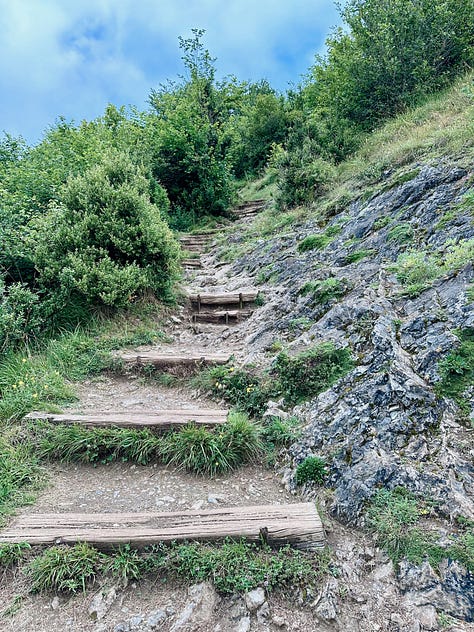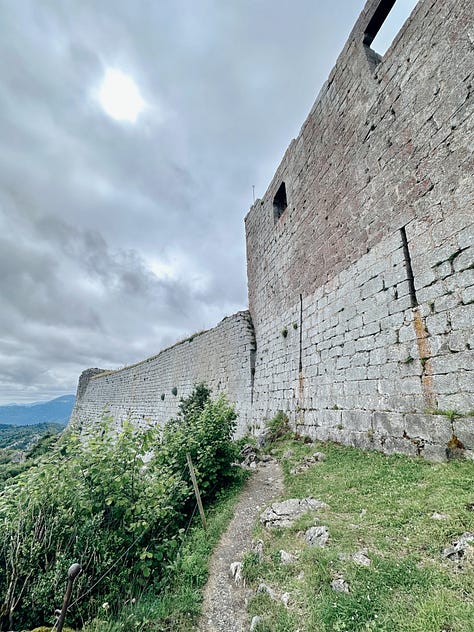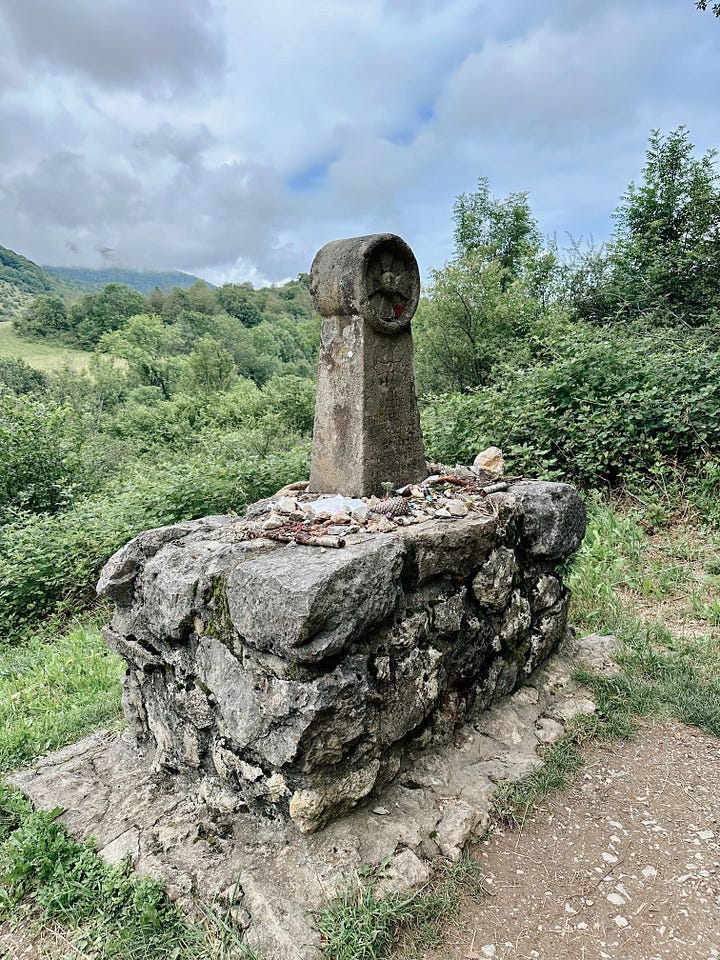The End Is Where I Began: Montségur
Sharing my solo pilgrimage into the lands and hearts of the Cathar
I have been under a spell for some time now. I know this enchantment, it feels divine and clear and lately like I’m possessed and driven - to study, to know, to go…
The nature of this path is that the more you want to know, the more you are shown: open wide and receive, or as the saying goes “for those with ears to hear and eyes to see…”
This path is the path of a believer, the path of a pilgrim.
I’ve been steeping myself for months, years actually, in the works of many authors on the subject of Mary Magdalene and Jesus, and most recently on their connection to France. I’ve shared before that my connection to France is an old one, this is not my first time here and the gift of remembering is ongoing as I live my days in Paris.
My studies began years ago with the help of Karen L. King as I began to dive into this respected theologian’s perspective on the lost and hidden teachings from the Gospel of Mary of Magdala. From there I discovered the wondrous world of Meggan Watterson, another theologian whom I deeply respect. My foundation is almost always based on a though-filled approach of real facts, details and deep study at first.
Beyond the gospel, I felt drawn to Mary’s cave in Sainte Baume instantly and answered the call for the first time four years ago - and I return every year in September. For me, this place in France is incredibly sacred.
This year my theological studies have expanded to include Akashic records, ancient ley lines, sacred geometry, bloodlines, fictional tales, legends, secret teachings and hidden mysteries as well as all things sacred Paris and beyond. I’m marveling at the words of Ani Williams, Timothy Freke, Daniel Meurois, Janet Renu Pullen, Mieke Vulink, Kathleen McGowan and so many others (if you are reading this and would like my pilgrimage reading list send me a little note and I’ll share it with you).
Somewhere along the way I became profoundly moved (and fascinated) by the story of the Cathars. (“Cathari, (from Greek katharos, “pure”), also spelled Cathars, were a heretical Christian sect that flourished in western Europe in the 12th and 13th centuries.) The Cathars were a version of Christians and often considered Gnostics, but everything they believed threatened the Catholic church: they believed in the duality of body and spirit (protecting the spirit with ceremony and ritual to return to the “good god” after death), they believed in reincarnation, they were opposed to the doctrine of sin, they didn’t believe in marriage, women were prominent in their faith (their connection to Mary Magdalene was my red thread to them), they were pacifists and vegetarians. They preached tolerance of other faiths and believed in the New Testament. To the Cathars the material world was considered evil and corrupt, therefore they rejected the human nature of Jesus and argued he was solely a spirit.
It’s easy to feel into their plight and understand why they were marked as heretics and how most if not all of this was considered heresy to the Catholic church.
In addition to my newly-founded empathy and fascination with these Gnostics, I also found myself completely captured by the mystery of their connection to the legends of the Holy Grail. (As I peer up at you from the bottom of this rabbit hole I’ve been in for awhile now, I can confidently tell you that I fully understand how many of us get lost forever down here…)
"They crucified Christ for heresy, so to be named a heretic is to be one with Him.”
― Bernard Cornwell
I began planning a short four-day solo pilgrimage a few months ago deep into the lands of the Cathar and Knights Templar in the South of France. Mapping out my plan has been a practice of following my heart based on what I have been studying, and feeling into where I am being guided on my path.
“What we call the beginning is often the end. And to make an end is to make a beginning.
The end is where we start from.”― T.S. Eliot
I felt a clear pull to visit Château de Montségur on the first day once arriving in Toulouse, knowing full well that I was beginning at the end of the story. Montségur is ancient (the earliest signs of life date back to the Stone Age), with evidence of Roman occupation. In about 1204 this castle was refortified after being in ruins for more than 40 years and it became a center of Cathar activities. The name Montségur from Latin mont ségur means “safe hill.” This castle became the home of Guilhabert de Castres, a Cathar theologian and bishop, and in 1233 the site became “the seat and head” of the Cathar church and it housed about 500 people of which 211 of them were “Perfects” or Perfecti (a name give to Cathars who were considered “perfect heretics,” spiritualized angels who were living perfectly according to their doctrine). These Perfecti were drawn from all walks of life, and even women could be Perfecti (they were called Parfaites or Perfectae).



I was prepared to feel the story deeply, but I was not prepared for just how deeply it hit me when I arrived on the land. The sorrow is palpable, the air is filled with a somber stillness, the wind whispers in all of the little sacred crevices of stone - of a time past and a violent history.
I felt it all with each light and careful step to the top.
The truth is that the walls there now are not the original ones, the rebuilt castle was destroyed after a nine-month siege. However there are still traces of authentic Cathar habitations on this mountain, and you can feel this.
In the days prior to the fall of the fortress, several Cathars allegedly slipped through the besiegers' lines. This led to legends that they escaped with a secret treasure or esoteric knowledge. The legends say that the Cathars fled to this mountaintop château with their church treasury, which supposedly included the Holy Grail.
The castle was sieged and conquered by an army of 10,000 sent by the church. This army attacked the castle while it was being held by about 100 fighters, along with nearby refugees and the Perfecti who did not participate in the fight.
“Surrender conditions were quickly decided on: all the people in the castle were allowed to leave except those who would not renounce their Cathar faith, primarily the Perfecti. A two-week truce was declared. The last two weeks were spent praying and fasting. A number of defenders decided to join the about 190 Perfecti and received their consolamentum bringing the total number of Cathar believers destined to burn to between 210 and 215.”


“On 16 March, led by Bishop Bertrand Marty, the group left the castle and went down to the place where the wood for the pyre had been erected. No stakes were needed: they mounted the pyre and perished voluntarily in the flames.”
“Do not be afraid; our fate
Cannot be taken from us; it is a gift.”― Dante Alighieri, Inferno
Descending the mountain I felt my heart begin to ache and the tears began to silently stream down my cheeks as I neared the "Prat dels Cremats" (Occitan for "Field of the Burned") at the foot of the mountain. Standing before the modern stele that honors the death of the victims I could feel the certainty of their faith, their conviction…their fate…and it felt so incredibly sad, yet beautiful, too.
Inscribed on this stele: "Als catars, als martirs del pur amor crestian. 16 de març 1244" (Occitan for "To the Cathars, to the martyrs of pure christian love. 16 March 1244").







Lovely writing, thank you, the energy and your conscious presencing is palpable, and beautiful energy in the photos.
Thanks for sharing this story of your experience. I'm sure the descent down the hill was very powerful indeed ~ I can imagine it ~ connecting to the energy of their final descent. Wow... and that they willingly stepped up into the fire. Powerful devotion.
Your description of the Perfects gives me a new perspective on my 'perfectionism' and strongly holding myself in integrity in certain ways (although I'm still very human and perfectly imperfect!).